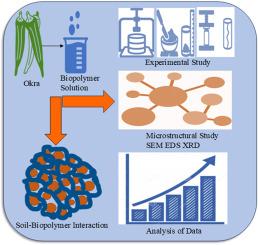Exploring okra-based biopolymer as a green binder for stabilizing clayey soil
IF 5.8
2区 化学
Q2 CHEMISTRY, MULTIDISCIPLINARY
引用次数: 0
Abstract
The requirement for sustainable soil stabilization techniques has increased interest in natural and eco-friendly alternatives to conventional soil stabilizers. This study presents the first attempt to utilize okra mucilage solution—a biopolymer derived from Abelmoschus esculentus—for the stabilization of clayey soil. The okra mucilage solution is a safe and environmentally friendly material. Its mucilage, a viscous material high in organic polysaccharides, offers potential for soil stability. The okra mucilage solutions were prepared in three concentrations by weight-to-volume ratios of 1:30 (1 g okra: 30 ml water), 1:20 (1 g okra: 20 ml water), and 1:10 (1 g okra: 10 ml water), respectively and applied to clayey soil to assess its consistency limits, compaction, and unconfined compressive strength (UCS) at different curing periods. The UCS of untreated soil increased from 207.82 kPa to 293.93 kPa, 338.49 kPa, and 380.22 kPa for the 1:30, 1:20, and 1:10 concentrations, respectively, after 28 days of curing. The maximum value of UCS was found at a 90-day curing period for a 1:10 concentration. The treatment further improved the consistency limits and compaction characteristics. Scanning electron microscopy (SEM), energy-dispersive X-ray spectroscopy (EDX), and X-ray diffraction (XRD) analyses provided microscopic insights, supplementing the lab testing and helping to estimate the internal mechanism. Analysis of variance (ANOVA) on UCS data yielded significant results, further confirming the significance of the results. Okra mucilage shows strong potential as a sustainable, readily available alternative to conventional soil stabilizers.

秋葵基生物聚合物作为稳定粘土的绿色粘合剂的探索
对可持续土壤稳定技术的需求增加了人们对传统土壤稳定剂的自然和生态友好替代品的兴趣。本研究首次尝试利用秋葵粘液溶液(一种来自秋葵的生物聚合物)来稳定粘土。秋葵粘液溶液是一种安全环保的材料。它的黏液,一种有机多糖含量高的粘性物质,为土壤的稳定性提供了潜力。分别按1:30 (1g秋葵:30ml水)、1:20 (1g秋葵:20ml水)和1:10 (1g秋葵:10ml水)三种浓度制备秋葵粘液溶液,并将其应用于粘土中,评估其在不同养护期的稠度极限、压实度和无侧限抗压强度(UCS)。当处理浓度为1:30、1:20和1:10时,未处理土的UCS分别从207.82 kPa增加到293.93 kPa、338.49 kPa和380.22 kPa。UCS的最大值出现在1:10浓度下90天的养护期。该处理进一步改善了稠度极限和压实特性。扫描电子显微镜(SEM)、能量色散x射线光谱(EDX)和x射线衍射(XRD)分析提供了微观视角,补充了实验室测试,并有助于估计内部机制。对UCS数据进行方差分析(ANOVA)得到显著结果,进一步证实了结果的显著性。秋葵粘液作为一种可持续的、易于获得的传统土壤稳定剂的替代品显示出强大的潜力。
本文章由计算机程序翻译,如有差异,请以英文原文为准。
求助全文
约1分钟内获得全文
求助全文
来源期刊

Sustainable Chemistry and Pharmacy
Environmental Science-Pollution
CiteScore
8.20
自引率
6.70%
发文量
274
审稿时长
37 days
期刊介绍:
Sustainable Chemistry and Pharmacy publishes research that is related to chemistry, pharmacy and sustainability science in a forward oriented manner. It provides a unique forum for the publication of innovative research on the intersection and overlap of chemistry and pharmacy on the one hand and sustainability on the other hand. This includes contributions related to increasing sustainability of chemistry and pharmaceutical science and industries itself as well as their products in relation to the contribution of these to sustainability itself. As an interdisciplinary and transdisciplinary journal it addresses all sustainability related issues along the life cycle of chemical and pharmaceutical products form resource related topics until the end of life of products. This includes not only natural science based approaches and issues but also from humanities, social science and economics as far as they are dealing with sustainability related to chemistry and pharmacy. Sustainable Chemistry and Pharmacy aims at bridging between disciplines as well as developing and developed countries.
 求助内容:
求助内容: 应助结果提醒方式:
应助结果提醒方式:


